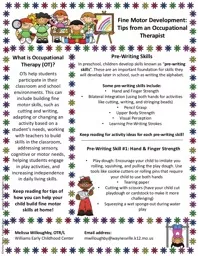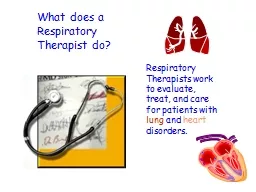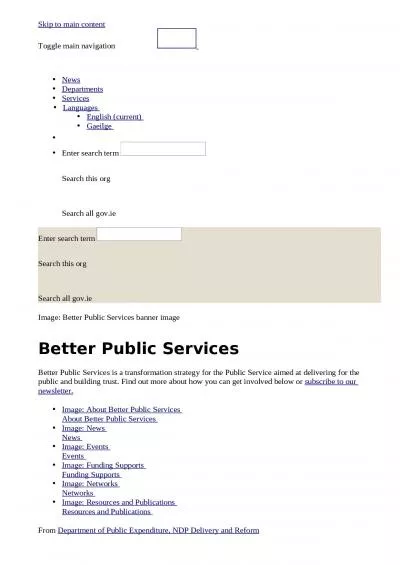PPT-Fine Motor Development: Tips from an Occupational Therapist
Author : nonhurmer | Published Date : 2020-06-17
What is Occupational Therapy OT PreWriting Skills Melissa Willoughby OTRL Email address Williams Early Childhood Center mwilloughbywaynesvillek12mous OTs help
Presentation Embed Code
Download Presentation
Download Presentation The PPT/PDF document "Fine Motor Development: Tips from an Occ..." is the property of its rightful owner. Permission is granted to download and print the materials on this website for personal, non-commercial use only, and to display it on your personal computer provided you do not modify the materials and that you retain all copyright notices contained in the materials. By downloading content from our website, you accept the terms of this agreement.
Fine Motor Development: Tips from an Occupational Therapist: Transcript
What is Occupational Therapy OT PreWriting Skills Melissa Willoughby OTRL Email address Williams Early Childhood Center mwilloughbywaynesvillek12mous OTs help students participate in their classroom and school environments This can include building fine motor skills such as cutting and writing adapting or changing an activity based on a students needs working with teachers to build skills in the classroom addressing sensory cognitive or motor needs helping students engage in play activities and increasing independence in daily living skills . By: Josh Fleisher. 21. st. Century Health. Chiropractor, What Do They Do?. People go to a chiropractor when they have . problems with their . neuro musculoskeletal . system, which includes nerves, bones, muscles, ligaments, and tendons. Derek Cuff, M.D.. Suncoast Orthopaedic Surgery and Sports Medicine. Goals. Discuss the role therapy plays. Discuss ways to improve communication. Discuss ways to improve education. Encourage you to document your value. . What are Fine Motor Skills?. Fine motor skills. are . small. movements — such as picking up . small. objects and holding a spoon — that use the . small. muscles of the fingers, toes, wrists, lips, and tongue. . By: Meryl . Abag. The Rehabilitation process that helps individuals relearn the skills they need to be independent through the use of therapeutic activities . What is Occupational Therapy?. Enhances people’s ability to perform tasks in their daily living and work environment . Respiratory Therapists work to evaluate, treat, and care for patients with . lung. and . heart. disorders.. What kinds of patients do Respiratory Therapists Treat?. Lung disease patients. Heart patients. By Sharon Creech. Pictures by Harry Bliss. principal. The head of a school. The . principal. . of Bridge City Intermediate is a woman . named Dr. . Fountain. . . Soared. To rise or fly high in the air.. Early Childhood 3-8 years-old. Gross motor skill changes 3-8 years. During the preschool years (ages 3/4) and primary school key stage 1 & 2 (aged 5-8) a child learns various new gross motor skills. These new skills are vital for playing with their peers. Each child learns these at a different rate, however the following is an general outline of the development of gross motor skills during the preschool years. Kimberly Holt, OTR, OTD. “The only thing worse than being blind is having sight but no vision.”. . (Keller, 1996). Purpose. This continuing education program will educate occupational therapists (OTs) about evidence-based interventions that address low-vision, including low vision equipment, environmental modifications, reading ability, community accessibility, safety, and performance of activities of daily living (ADLs) and instrumental activities of daily living (IADLs) to allow clients to increase their participation in their desired occupations. Kimberly Holt, OTR, OTD. “The only thing worse than being blind is having sight but no vision.”. . (Keller, 1996). Purpose. This continuing education program will educate occupational therapists (OTs) about evidence-based interventions that address low-vision, including low vision equipment, environmental modifications, reading ability, community accessibility, safety, and performance of activities of daily living (ADLs) and instrumental activities of daily living (IADLs) to allow clients to increase their participation in their desired occupations. Role. Updated . 6. /13/2018. Rehabilitation Therapist Role. Includes physical and occupational therapists. Assess a child’s physical capabilities and determine ways to improve a child’s interaction with their environment . Beautiful Floral journal design, perfect gift for writing in, for a gift for the hard to buy for. Lovely purple and green flowers make this a winner all the way around. Small floral heart embellishment on interior pages gives it a touch of class. Perfect idea for a gift basket item.Features:108 lined pagesLuxurious matte finish coverPerfect bound for easy storageNo wires to get hung up on clothesOur cute notebooks make the perfect gift for many holidays and occasions.Christmas giftsThanksgiving giftsGifts under 10 dollarsWhite Elephant GiftsBible Study notesPrayer journalGift for teachersTo Do listsBirthday giftsWedding giftsGraduation GiftsBridal Shower giftBaby shower giftGift for new jobGift for new houseGift for new employee chemo brain , chemo fog or Cancer Rel ated Cognitive Deficits (CRCD) CR CD refers to problems with memory and/or concentration that patient s may experience during and after cancer treatment HSE Dublin South West. Russell Building Tallaght Cross West, Dublin 24 . Tel: 01 7957553 email: . kelly.harrison@hse.ie. Equine Assisted Occupational Therapy. Cherry Orchard Equine Centre, Ballyfermot, Dublin 10. . MASCIP Annual Conference. Loughborough University. 16. th. November 2023 . MEHDI BELBAHI. OCCUPATIONAL THERAPIST.
Download Document
Here is the link to download the presentation.
"Fine Motor Development: Tips from an Occupational Therapist"The content belongs to its owner. You may download and print it for personal use, without modification, and keep all copyright notices. By downloading, you agree to these terms.
Related Documents














